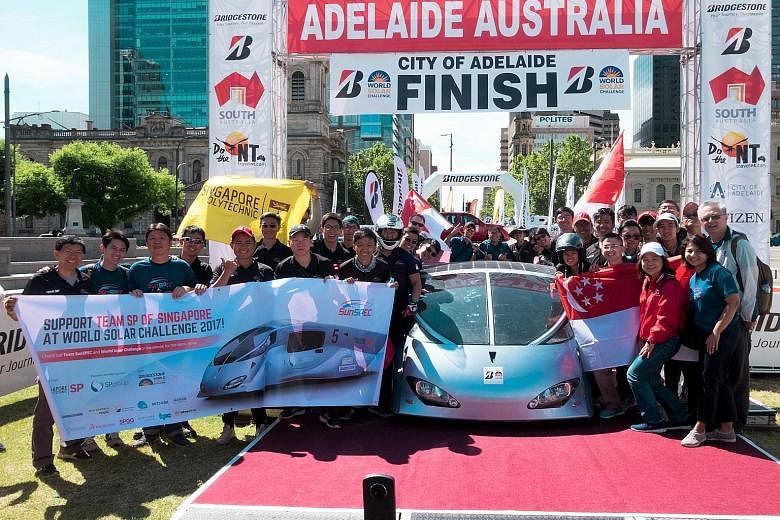His life flashed before his eyes as he smelled smoke.
A punctured front tyre sent the prototype solar car that electrical and electronic engineering student Ngah Phek Siang, 22, was in veering sharply to the right - into the path of an oncoming road train, a type of long trucking vehicle.
Fortunately, the driver of the SunSPEC5 car, Ms Krystal Wong, 22, remained calm and yanked hard on the steering wheel, wrestling the car safely to the left and off the road, but not before leaving a 200m-long skid mark in her wake.
The two Singapore Polytechnic students were participating in the 2017 World Solar Challenge, as part of the SunSPEC team, a group consisting of 35 volunteer Year 3 students, 12 lecturers, and three alumni who now work at utility company SP Group.
From Oct 8 to 12, they raced against 39 other teams from around the world along a 3,000km race course from Darwin to Adelaide in Australia.
That accident, though, threw a spanner in the works for the team, in what was already one of the toughest competitions out there for experimental solar vehicles.
In the World Solar Challenge held once every two years, besides strict car design criteria, participants must also design for the unforgiving Australian outback, where temperatures fluctuate from single digits to 40 deg C within a single day, and heavy thunderstorms.
This year, SunSPEC was the only team from Singapore, as well as the only polytechnic against universities such as Cambridge, the Massachusetts Institute of Technology and Stanford.
SunSPEC entered the cruiser category, which emphasises practicality, design and end-user appeal over speed. SunSPEC5 is the metaphorical offspring of the team's previous entry in 2015, SunSPEC4. It took 20 months from December 2015 to design and build.
Lecturer Foo Fang Siong, 48, who served as SunSPEC's assistant team manager, spent close to a year finalising its design. He took into account previous problems that the SunSPEC4 had encountered, such as a faulty wheel alignment that caused the steering wheel to veer left or right with every road bump.
This year, Mr Foo also made sure his drivers were comfortable.
"The seat (in 2015) was just two hard carbon fibre plates. The driver had to sit on that for the entire race.
This time he put in an ergonomic black and red leather seat, as well an adjustable steering wheel, he said.
The two drivers, Mr Sebert Fong, 20, and Ms Wong, both from the Diploma in Mechatronics and Robotics (DMRO) course, drove from 8am to 5pm every day, racing to reach each of the nine checkpoints along the route. To meet their daily time goals, they ate chocolate or granola bars behind the wheel, and even skipped toilet breaks at times.
Even then, SunSPEC5 failed to arrive in Adelaide on time. Heavy rains on the third day blocked out the sun, delaying the majority of the teams' charging time.
Out of 13 teams in the cruiser category, only three managed to finish the race within the final day's deadline, with the other 10 automatically given a near-failing score. SunSPEC received a total score of 51.5, compared with the winner, Solar Team Eindhoven, with 93.4.
"We have a lot more things to improve on," said Mr Fong.
Mr Seow Jing Woon, 19, from DMRO, said: "It was a tough race mentally." He was part of the crew that worked on SunSPEC5's suspension and brakes, one of several teams that kept the car running smoothly every day. "We need to make sure everything works... Before this race, I was a bit clumsy. Now I'm more careful."
Mr Joey Ang, 19, from the Diploma in Energy Systems and Management, appreciated the chance to interact with participants from other countries.
He recounted how the Kogakuin University Solar Team's car completely flipped over during a test drive. "Surprisingly, (the driver) still came back the next day. It taught me about resilience, and other countries' work ethics."
Solar cars are still some way from becoming part of daily life, said Mr Foo. "At the moment, we don't have any automotive manufacturing industry in Singapore as a precedent, so there's some difficulty in getting certification," he said. "And in Singapore, we have a lot of clouds and trees that cast shadows, which affects the solar panels' charging.
"But if the current trend of hybrid cars and other renewable energy sources continues, the average driver might be able to own a hybrid solar car within 10 years."

